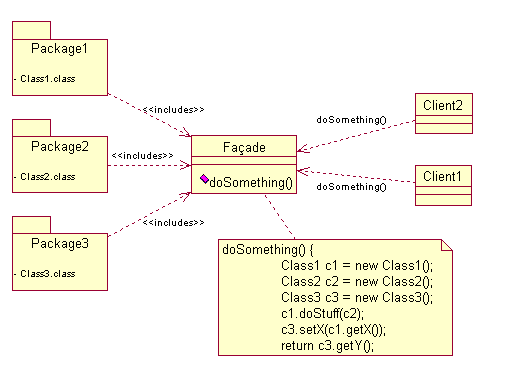外观模式
| 此条目需要精通或熟悉相关主题的编者参与及协助编辑。 (2012年1月24日) |
| 此条目没有列出任何参考或来源。 (2008年12月1日) |
外观模式(Facade pattern),是软件工程中常用的一种软件设计模式,它为子系统中的一组介面提供一个统一的高层介面,使得子系统更容易使用。
外观模式是一个设计模式 (计算机)中常用的面向对象程序设计. 类似于一个建筑学中的立面. 立面作为一个前端接口来屏蔽更复杂的底层或结构代码。外观模式可以:
- 通用简化的API屏蔽与更复杂的内部组件和结构, 以提高Software library的可读性和可用性
- 为更通用的功能提供上下文特定的接口
当一个系统非常复杂或难以理解时,开发人员通常会使用 facade 设计模式,因为该系统有许多相互依赖的类,或者因为其源代码不可用。Facade模式隐藏了更大系统的复杂性,为客户端提供了一个更简单的接口。通常会涉及到一个wrapper包含客户端所需的一组成员的。这些成员代表 facade 客户端访问系统并隐藏实现细节。
结构[编辑]
- Facade
- 这个外观类为子系统中Packages 1、2、3提供一个共同的对外介面(接口)
- Clients
- 客户对象通过一个外观介面读写子系统中各介面的数据资源。
- Packages
- 客户可以通过外观介面读取的内部库。
示例[编辑]
Java[编辑]
这是一个抽象的范例。一个客户“you”通过外观介面“computer”获取计算机内部复杂的系统信息。
/* Complex parts */
class CPU {
public void freeze() { ... }
public void jump(long position) { ... }
public void execute() { ... }
}
class Memory {
public void load(long position, byte[] data) {
...
}
}
class HardDrive {
public byte[] read(long lba, int size) {
...
}
}
/* Façade */
class Computer {
public void startComputer() {
cpu.freeze();
memory.load(BOOT_ADDRESS, hardDrive.read(BOOT_SECTOR, SECTOR_SIZE));
cpu.jump(BOOT_ADDRESS);
cpu.execute();
}
}
/* Client */
class You {
public static void main(String[] args) {
Computer facade = new Computer();
facade.startComputer();
}
}
C#[编辑]
// Facade pattern -- Structural example
using System;
namespace DoFactory.GangOfFour.Facade.Structural
{
// Mainapp test application
class MainApp
{
public static void Main()
{
Facade facade = new Facade();
facade.MethodA();
facade.MethodB();
// Wait for user
Console.Read();
}
}
// "Subsystem ClassA"
class SubSystemOne
{
public void MethodOne()
{
Console.WriteLine(" SubSystemOne Method");
}
}
// Subsystem ClassB"
class SubSystemTwo
{
public void MethodTwo()
{
Console.WriteLine(" SubSystemTwo Method");
}
}
// Subsystem ClassC"
class SubSystemThree
{
public void MethodThree()
{
Console.WriteLine(" SubSystemThree Method");
}
}
// Subsystem ClassD"
class SubSystemFour
{
public void MethodFour()
{
Console.WriteLine(" SubSystemFour Method");
}
}
// "Facade"
class Facade
{
SubSystemOne one;
SubSystemTwo two;
SubSystemThree three;
SubSystemFour four;
public Facade()
{
one = new SubSystemOne();
two = new SubSystemTwo();
three = new SubSystemThree();
four = new SubSystemFour();
}
public void MethodA()
{
Console.WriteLine("\nMethodA() ---- ");
one.MethodOne();
two.MethodTwo();
four.MethodFour();
}
public void MethodB()
{
Console.WriteLine("\nMethodB() ---- ");
two.MethodTwo();
three.MethodThree();
}
}
}
C++[编辑]
class CPU {
public:
void freeze() { ... }
void jump(long position) { ... }
void execute() { ... }
}
class Memory {
public:
void load(long position, char* data) {
...
}
}
class HardDrive {
public:
char* read(long lba, int size) {
...
}
}
/* Façade */
class Computer {
public:
void startComputer() {
cpu.freeze();
memory.load(BOOT_ADDRESS, hardDrive.read(BOOT_SECTOR, SECTOR_SIZE));
cpu.jump(BOOT_ADDRESS);
cpu.execute();
}
}
/* Client */
class You {
public:
void start(String[] args) {
Computer facade = new Computer();
facade.startComputer();
}
}
| ||||||||||||||||||||||||||||||||||||||||||||||||||||||

